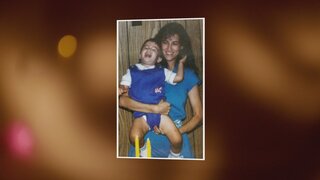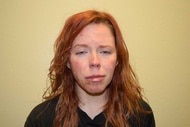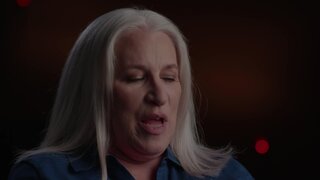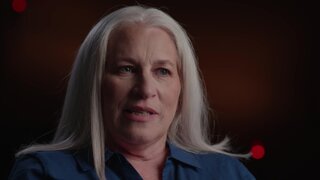Create a free profile to get unlimited access to exclusive videos, breaking news, sweepstakes, and more!
Navy Spouse Raped, Murdered In Florida After Her Husband Is Deployed For 6 Months
Dina Kichler was brutally killed in December of 1990; a shockingly similar case in New Hampshire three years earlier would ultimately help bring her killer to justice.

Dina Kichler, a vivacious young mother and wife, had recently started a new life in the quiet town of Mayport, Florida, with her husband, Pat, a Navy officer, and their 2-year-old son when tragedy struck at the end of 1990.
On Monday, Dec. 3, Dina didn’t show up to her job at the front desk of an optics store in Jacksonville, worrying her colleagues. After all, this was somebody who was known for always coming into work on time with a smile on her face.
“I do recall sitting and wondering where she was because she hadn’t shown up,” Amy Stark, Dina’s friend and co-worker, says in the season premier of “In Ice Cold Blood,” an Oxygen true crime anthology series hosted by Ice-T. “I was very concerned.”
After calling Kichler’s house and getting no answer, Stark drove over to her friend’s apartment in Mayport Landing, a complex for military families. She saw Kichler’s car was still in the driveway; after speaking to neighbors to see if they’d seen or heard anything of note, Stark called the police.
The responding officer would discover a gruesome and bloody scene.
“He saw blood in the foyer; he saw signs of a struggle,” prosecutor Jay Taylor says in the episode, adding that the officer called in the homicide unit after discovering a human foot sticking out of a pile of disheveled blankets in the master bedroom.
In addition to the blood splatters, detectives noticed wads of dark hair around the house: a wad wedged inside a hole near the staircase leading up to the loft bedroom, and a larger amount that could have been chopped off, left in the bathtub next to the bedroom. They also took note that there were no signs of forced entry into the apartment.
Eventually, the detectives and the medical examiner methodically peeled back the pile of blankets and clothing and came upon Kichler’s battered corpse.
“What do I see? Something that’s still in my nightmares today,” Anthony “Butch” Berry, an assistant state attorney, says.
It was determined that Dina Kichler was raped and then choked to death with a rope. In addition to the blood and tufts of the victim’s hair, detectives discovered a snuffed-out cigarette in the bathroom, and three hair samples — determined to be pubic, inner thigh and leg hairs — embedded within the linens Kichler's body was wrapped in, potentially from her killer.
After her husband was immediately ruled out as a potential suspect due to the fact that he was deployed at the time (their toddler, meanwhile, was off staying with family members), a slew of suspects emerged, particularly some male colleagues from the optics store and acquaintances that seemed romantically interested in the victim.
“Every male we contacted was enthralled with Dina,” Berry says.
There were colleagues from the optics store: Jonathan, who had told investigators he ventured over to the crime scene after the murder; Steve, a “hot-headed” co-worker who was vocal about his unhappy marriage and attraction to Dina; and Dennis, who not only worked at the optics store with Dina, but also at one point lived in the same trailer park as her and her husband.
But when detectives took and tested hair samples from each of these men, none were matches.
Frustrated but not deterred, detectives were back at the crime scene two weeks after the murder to sweep for potential clues. Monroe says he came across a previously undiscovered address book in a nightstand. After flipping through it, a name that Dennis had given investigators jumped out at him: John Brewer.
“Detectives learned from Dennis that John Brewer also lived in the same mobile home park that the Kichlers had lived in,” Taylor says.
Investigators found out that Brewer, like the other three men they'd looked into, was infatuated with Dina.
Investigators started taking Brewer seriously as a potential suspect after he told them he'd been in the Kichlers’ apartment prior to the homicide, his reason being that he was thinking of renting a place in the same complex and wanted to get a better look at the master bathroom’s floorplan. It also helped that detectives noticed Brewer smoked the same brand of cigarettes as the one found at the crime scene — the one smooshed into a bloody boot print — and that he had cuts all over his hands.
It would take investigators a while to successfully pin the crime on Brewer, even though they were all but certain he was their man.
At first, for instance, the three hair samples that Brewer gave to investigators proved to be inconclusive. But after authorities shipped the samples to the FBI’s crime lab, the feds revealed five months later that Brewer had duped investigators and gave them hair samples from the wrong part of his body. When detectives tried to track Brewer down to get the right samples, he had effectively vanished.
“Because he lied to us, I believe he realized that we’re onto him,” Monroe says.
Ultimately, they tracked Brewer down almost a year after the murder and got the correct hair samples — they were a match. On Dec. 12, 1991, Brewer was booked and charged with the murder of Dina Kichler.
But it would take several more years — and a number of setbacks — for Dina Kichler’s loved ones to get a taste of the justice they so craved.
On Nov. 3, 1993, Brewer was released after Circuit Judge Lawrence Haddock ruled there wasn’t enough evidence to hold Brewer without bond, the Palm Beach Post reported at the time. The decision was informed by the fact that Brewer admitted to investigators he had been in the Kichlers’ apartment prior to Dina’s murder, worrying prosecutors that a competent defense attorney might be able to use that information to sow doubt over those three crucial hair samples.
It would be more than seven years before authorities would gain any new traction on Dina Kichler’s murder case. It came from an unexpected source.
James Tucker, a retired captain with the Portsmouth Police Department in New Hampshire, says that while he was attending a conference in Florida on cold cases, the details of the Kichler murder struck him as very similar to the unsolved 1987 murder of Michele LaFond.
LaFond, 23, was found raped and murdered in her home in Dublin, N.H. on March 4, 1987. LaFond, who was four months pregnant at the time of the slaying, was found by her husband.
In addition to the two women bearing a striking resemblance — they almost looked like sisters — both women were found to have been murdered by strangulation.
Working together, police in Florida and New Hampshire were able to match DNA found in semen recovered from the LaFond crime scene to the hair follicles found in the Kichler case, thus linking Brewer to both crimes.
Brewer was arrested for his alleged role in both killings in April 1998. In the summer of 1999, the 41-year-old Brewer received two life sentences after pleading guilty to both murders, the Associated Press reported at the time.
“After John Brewer plead[ed] guilty, it was like a relief,” Amy Stark, Dina Kichler’s colleague at the optics store, says. “It finally was closed.”






























